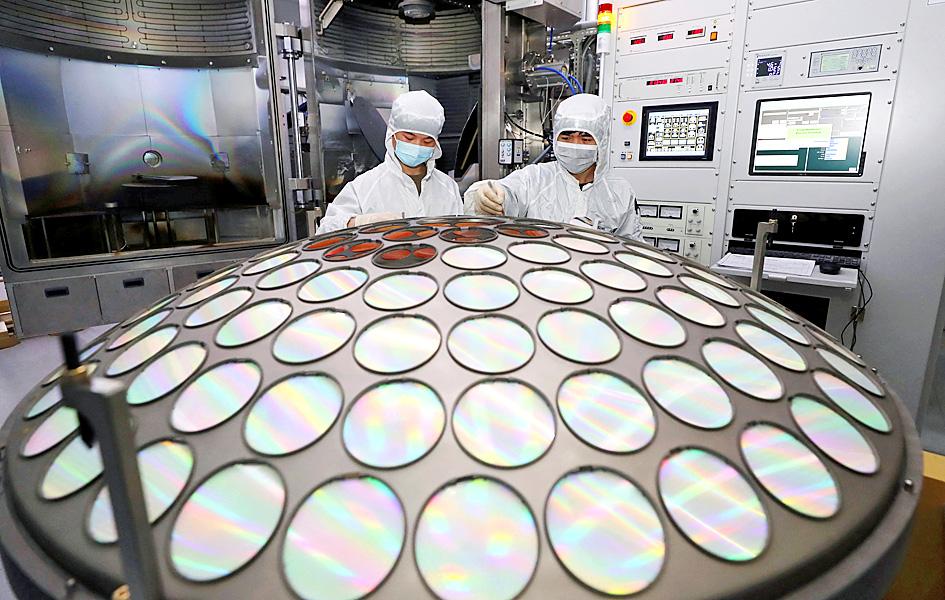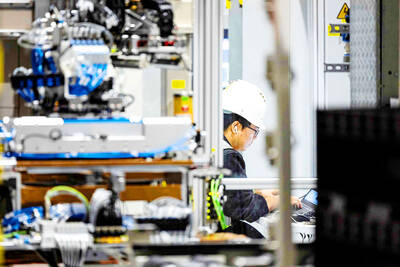Taiwan is to become the world’s largest spender on front-end chip manufacturing equipment this year, thanks to robust demand for chips used in vehicles and high-performance computing devices, international trade group SEMI said yesterday.
Fab equipment spending in Taiwan is forecast to rise 52 percent year-on-year to US$34 billion this year, ahead of South Korea’s US$25.5 billion, where it would be up 6 percent from the previous year, and US$17 billion in China, down 14 percent from its peak last year, SEMI said in its World Fab Forecast report.
Moreover, Europe and the Mideast combined would register record spending of US$9.3 billion this year, an annual surge of 176 percent, the report said.

Photo: Reuters
Overall, global fab equipment spending is expected to increase 20 percent this year to a record level of US$109 billion from US$91 billion last year, marking a third consecutive year of growth following a 42 percent surge last year, the report said.
Taiwan, South Korea and Southeast Asia are expected to register record investments this year, it added.
The global semiconductor equipment industry is on track to cross the US$100 billion threshold for the first time this year, SEMI said.
“This historic milestone puts an exclamation point on the current run of unprecedented industry growth,” SEMI president and chief executive officer Ajit Manocha said in a statement.
Total capacity in the global semiconductor industry is to expand by 8 percent this year after a 7 percent increase last year, and the growth is expected to continue next year with an annual growth of 6 percent, it said.
“The world semiconductor market was affected by changes in demand for end devices and inflation, causing a short-term inventory adjustment for chips used in certain electronic products, but, the industry is still on track to meet its long-term growth targets, benefiting from strong demand for automotive electronics and high-performance computing applications,” SEMI Taiwan president Terry Tsao (曹世綸) said in a statement.
The SEMI report showed that more than 85 percent of the spending on equipment this year would stem from capacity increases at 158 fabs and production lines.
The ratio is expected to be 83 percent next year after 129 fabs and production lines add capacity, it said.
The foundry sector is to account for the bulk of equipment spending this year and next year at about 53 percent, followed by the memory sector at 33 percent this year and 34 percent next year, the report said.
The forecast comes as major Taiwanese foundries are boosting capital spending this year to address a global chip shortage.
Taiwan Semiconductor Manufacturing Co (台積電) has budgeted record expenditure on equipment of US$40 billion to US$44 billion this year, including back-end equipment for chip testing and packaging services, while United Microelectronics Corp (聯電) has doubled its capital expenditure this year to US$3.6 billion from US$1.8 billion last year as it adds capacity at its fabs.

CHIP RACE: Three years of overbroad export controls drove foreign competitors to pursue their own AI chips, and ‘cost US taxpayers billions of dollars,’ Nvidia said China has figured out the US strategy for allowing it to buy Nvidia Corp’s H200s and is rejecting the artificial intelligence (AI) chip in favor of domestically developed semiconductors, White House AI adviser David Sacks said, citing news reports. US President Donald Trump on Monday said that he would allow shipments of Nvidia’s H200 chips to China, part of an administration effort backed by Sacks to challenge Chinese tech champions such as Huawei Technologies Co (華為) by bringing US competition to their home market. On Friday, Sacks signaled that he was uncertain about whether that approach would work. “They’re rejecting our chips,” Sacks

It is challenging to build infrastructure in much of Europe. Constrained budgets and polarized politics tend to undermine long-term projects, forcing officials to react to emergencies rather than plan for the future. Not in Austria. Today, the country is to officially open its Koralmbahn tunnel, the 5.9 billion euro (US$6.9 billion) centerpiece of a groundbreaking new railway that will eventually run from Poland’s Baltic coast to the Adriatic Sea, transforming travel within Austria and positioning the Alpine nation at the forefront of logistics in Europe. “It is Austria’s biggest socio-economic experiment in over a century,” said Eric Kirschner, an economist at Graz-based Joanneum

BUBBLE? Only a handful of companies are seeing rapid revenue growth and higher valuations, and it is not enough to call the AI trend a transformation, an analyst said Artificial intelligence (AI) is entering a more challenging phase next year as companies move beyond experimentation and begin demanding clear financial returns from a technology that has delivered big gains to only a small group of early adopters, PricewaterhouseCoopers (PwC) Taiwan said yesterday. Most organizations have been able to justify AI investments through cost recovery or modest efficiency gains, but few have achieved meaningful revenue growth or long-term competitive advantage, the consultancy said in its 2026 AI Business Predictions report. This growing performance gap is forcing executives to reconsider how AI is deployed across their organizations, it said. “Many companies

France is developing domestic production of electric vehicle (EV) batteries with an eye on industrial independence, but Asian experts are proving key in launching operations. In the Verkor factory outside the northern city of Dunkirk, which was inaugurated on Thursday, foreign specialists, notably from South Korea and Malaysia, are training the local staff. Verkor is the third battery gigafactory to open in northern France in a region that has become known as “Battery Valley.” At the Automotive Energy Supply Corp (AESC) factory near the city of Douai, where production has been under way for several months, Chinese engineers and technicians supervise French recruits. “They